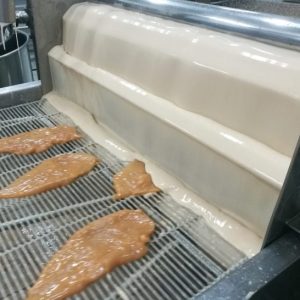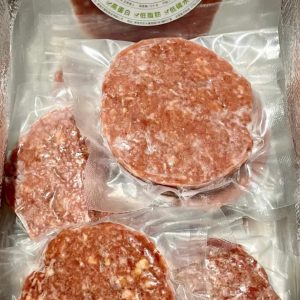Вы когда-нибудь задумывались, как хрустящий кусочек куриного лакомства оказывается в морозилке в идеальной форме и готовым к приготовлению? Промышленное производство куриных наггетсов - это чудо современной пищевой инженерии, сочетающее в себе эффективность, безопасность продуктов и неизменное качество. Давайте приоткроем занавес этого увлекательного сборочного конвейера.
1. Поиск и подготовка: Сырье
- Прибытие цыпленка: Целые куры или отдельные части (например, мясо грудки или бедра, часто с механической разделкой - MSC) поступают на завод в охлажденном или замороженном виде.
- Осмотр и обвалка: Мясо проходит тщательную проверку на качество и безопасность. Кости тщательно удаляются. Для MSC машины отделяют съедобное мясо от костей с помощью давления.
- Измельчение: Обрезки куриного мяса измельчают в крупную пасту или мелкий фарш. Получается базовый "кляр" или "эмульсия".
2. Смесь: Вкус и функция
- Магия смешивания: Куриный фарш поступает в большие промышленные миксеры. Здесь происходит точное смешивание ингредиентов:
- Папки: Крахмал (кукурузный, картофельный, пшеничный), протеины (соевый, молочный) или камеди помогают удерживать влагу и удерживать все вместе.
- Приправы: Соль, перец, специи, усилители вкуса (например, дрожжевой экстракт), а иногда и сушеные овощи (лук, чесночный порошок) создают фирменный вкус.
- Увлажнение и текстура: Вода или лед добавляются для придания консистенции и сочности. Фосфаты могут быть включены для улучшения удержания воды.
- Образование эмульсии: Смесь смешивается в контролируемых условиях (часто холодных) до образования однородной, липкой пасты. Это очень важно для текстуры самородка.
3. Придание формы: От пасты до идеальной формы
- Формовочные машины: Куриная паста закачивается в высокоскоростные формовочные машины. В них паста формуется в классические формы самородков: круги, динозавры, звезды или простые прямоугольники/блоки.
- Экструзия и резка: В некоторых линиях используется экструзия - выдавливание пасты через фигурное отверстие, после чего высокоскоростные ножи разрезают ее на точные отрезки.
4. Каскад покрытий: Создание хруста
- Предварительное покрытие (по желанию): Сначала котлетки можно слегка присыпать мукой или крахмалом. Это поможет следующим слоям лучше приклеиться.
- Ванна для баттера: Сформированные котлетки проходят через жидкий кляр (часто это смесь муки, крахмала, воды и приправ). Этот влажный слой необходим для того, чтобы панировка прилипла.
- Применение для панировки: Сразу после кляра наггетсы попадают в сухую панировку. Как правило, она состоит из панировочных сухарей, муки, кукурузной муки, крахмала и приправ. Вращающиеся барабаны или каскадные ложа обеспечивают равномерное и полное покрытие. Излишки стряхиваются.
5. Приготовление: Создание структуры и вкуса
- Пар-фри (частичное обжаривание): Это наиболее распространенный промышленный этап. Наггетсы проходят через фритюрницу непрерывного действия, наполненную горячим маслом (обычно растительным), в течение короткого времени (обычно 30-90 секунд). Это:
- Наносит покрытие, создавая первоначальную хрустящую корочку.
- Приготовьте внешний слой курицы, сохраняя влагу.
- Развивает аромат и золотистый цвет.
- Примечание: В некоторых заведениях на этом этапе вместо жарки используется запекание в духовке, чтобы получить продукт с пониженным содержанием жира.
- Внутренняя температура: Сердцевина при этом остается непрожаренной. При обжаривании поверхность быстро нагревается до высокой температуры.
6. Флэш-замораживание: Сохранение свежести
- IQF (индивидуальное быстрое замораживание): Приготовленные котлетки быстро перемещаются в камеру шоковой заморозки (от -30°C до -40°C или холоднее). Мощный холодный воздух замораживает каждую котлетку по отдельности за считанные минуты.
- Почему именно IQF? Предотвращает образование крупных кристаллов льда (которые портят текстуру), останавливает рост бактерий и позволяет наггетсам оставаться отдельными и свободно текущими в пакете.
7. Упаковка и дистрибуция: Готовим для вас
- Автоматизированное взвешивание и упаковка в мешки: Замороженные котлетки поступают на упаковочные линии. Машины взвешивают точные порции и укладывают их в пакеты (пластиковые пакеты или картонные коробки).
- Пломбирование и кодирование: Пакеты герметично закрываются для предотвращения пригорания и загрязнения. Напечатаны даты производства, коды партий и сроки годности.
- Упаковка в виде кейса: Отдельные пакеты упаковываются в большие картонные коробки для транспортировки.
- Хранение и распределение глубокой заморозки: Ящики хранятся в огромных промышленных морозильных камерах, а затем загружаются в рефрижераторы, предназначенные для продуктовых магазинов, ресторанов и распределительных центров по всему миру.
Качество и безопасность: Неизменные стражи
На протяжении всего этого процесса, Строгий контроль качества и протоколы безопасности пищевых продуктов имеют первостепенное значение:
- Планы HACCP: Системы анализа рисков и критических контрольных точек (HACCP) выявляют и контролируют потенциальные биологические, химические и физические риски.
- Обнаружение металлов: Самородки проходят через детекторы, улавливающие все фрагменты металла.
- Мониторинг температуры: Температура постоянно контролируется на критических этапах (приготовление, замораживание, хранение).
- Санитария: Оборудование и помещения подвергаются частой и тщательной очистке и санитарной обработке.
- Тестирование продукта: Случайные образцы отбираются для лабораторных исследований (микробиологических, сенсорных, качественных).
Результат: Последовательность в широком масштабе
Промышленный процесс производства куриных наггетсов - это свидетельство точной инженерии и пищевой науки. Он превращает сырую курицу в стабильный по форме, вкусу, текстуре и безопасности продукт, который может быть произведен млн каждый день, готовые в любой момент поджариться в вашей духовке или аэрофритюрнице. В следующий раз, когда вы будете наслаждаться самородком, вспомните, какой невероятный путь он проделал от фермы до вашей вилки!



